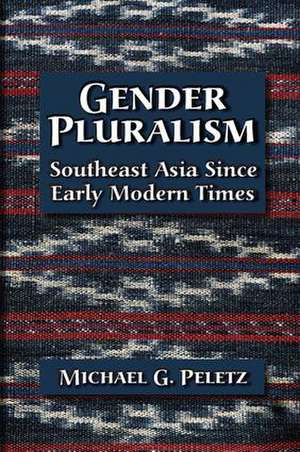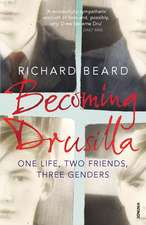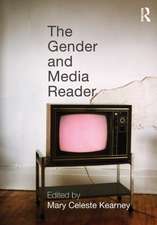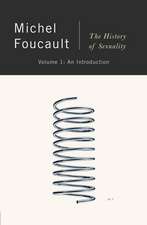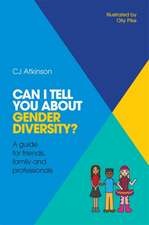Gender Pluralism: Southeast Asia Since Early Modern Times
Autor Michael G. Peletzen Limba Engleză Paperback – 15 apr 2009
This book examines three big ideas: difference, legitimacy, and pluralism. Of chief concern is how people construe and deal with variation among fellow human beings. Why under certain circumstances do people embrace even sanctify differences, or at least begrudgingly tolerate them, and why in other contexts are people less receptive to difference, sometimes overtly hostile to it and bent on its eradication? What are the cultural and political conditions conducive to the positive valorization and acceptance of difference? And, conversely, what conditions undermine or erode such positive views and acceptance? This book examines pluralism in gendered fields and domains in Southeast Asia since the early modern era, which historians and anthropologists of the region commonly define as the period extending roughly from the fifteenth to the eighteenth centuries.
| Toate formatele și edițiile | Preț | Express |
|---|---|---|
| Paperback (1) | 490.07 lei 6-8 săpt. | |
| Taylor & Francis – 15 apr 2009 | 490.07 lei 6-8 săpt. | |
| Hardback (1) | 1224.59 lei 6-8 săpt. | |
| Taylor & Francis – 15 apr 2009 | 1224.59 lei 6-8 săpt. |
Preț: 490.07 lei
Nou
Puncte Express: 735
Preț estimativ în valută:
93.79€ • 97.55$ • 77.43£
93.79€ • 97.55$ • 77.43£
Carte tipărită la comandă
Livrare economică 14-28 aprilie
Preluare comenzi: 021 569.72.76
Specificații
ISBN-13: 9780415931618
ISBN-10: 0415931614
Pagini: 352
Dimensiuni: 152 x 229 x 19 mm
Greutate: 0.47 kg
Ediția:1
Editura: Taylor & Francis
Colecția Routledge
Locul publicării:Oxford, United Kingdom
ISBN-10: 0415931614
Pagini: 352
Dimensiuni: 152 x 229 x 19 mm
Greutate: 0.47 kg
Ediția:1
Editura: Taylor & Francis
Colecția Routledge
Locul publicării:Oxford, United Kingdom
Cuprins
1. Introduction 2. Gender Pluralism and Transgender Practices in Early Modern Times 3. Temporary Marriage, Connubial Commerce, and Colonial Body Politics 4. Transgender Practices, Same-Sex Relations, and Gender Pluralism Since the 1960s 5. Gender, Sexuality, and Body Politics at the Turn of the Twenty-First Century Epilogue: Asylum, Diaspora, Pluralism
Notă biografică
Michael G. Peletz is Professor of Anthropology at Emory University. His specialties include social theory, gender, sexuality, Islam, and modernity, particularly in Southeast Asia. He is the author of Islamic Modern: Religious Courts and Cultural Politics in Malaysia (Princeton, 2002), Reason and Passion: Representations of Gender in a Malay Society (California, 1996), A Share of the Harvest: Kinship, Property, and Social History among the Malays of Rembau (California, 1988). He is also the co-editor with Aihwa Ong, of Bewitching Women, Pious Men: Gender and Body Politics in Southeast Asia (California, 1995).
Recenzii
In this ambitious book, Michael Peletz sets out to explore how and under what
conditions “gender pluralism” may develop and thrive in a society or nation-state.
Peletz uses “pluralism” to refer to instances in which certain types of diversity are
granted legitimacy. By “gender pluralism” he refers in particular to instances in which
forms and degrees of legitimacy are granted to culturally recognized inclinations,
behaviors, roles, relationships, and expressive forms associated with concepts that go
beyond a dualistic opposition of maleness and femaleness to include hermaphrodism,
androgyny, and other transgender possibilities.
Peletz locates his study in the broad coordinates of Southeast Asian geography and
history. In the course of his analysis, he draws on a wide array of cases from across the
region and across the centuries. He establishes a baseline in the fifteenth and sixteenth
centuries—the first half of the early modern period—to identify dimensions of gender
pluralism that existed in the region before European colonial influences became a
significant factor. He identifies a series of conditions supportive of the forms of gender
pluralism thereafter discussed in the book. These include the prevalence of bilateral
kinship systems that do not favor the male or the female line; dualistic cosmologies
with complementary female and male elements; roles for women in agricultural, life
cycle, and healing rituals; women’s participation in politics and trade; tolerance of
premarital sex; initiation of divorce by either party; and a relatively high degree of
autonomy and agency afforded to women.
Peletz posits that the transgender themes in the hegemonic forms of state ritual and
courtly practice built on and afforded legitimacy to behavior in the wider society. He
explores how polymorphic patterns of gender in the region were melded with and
reinforced by Southeast Asian forms of cosmology and statescraft, strongly inflected by
the Saivite and Tantric traditions of South Asia over the course of two millennia.
Importantly, he argues that transgender ritual practices were not transgressive
exceptions to societal conventions, but rather were consistent with gender pluralism in
society at large. Gender pluralism in this era included legitimate sexual relations
between same-sex partners who were differentiated genderwise by markers such as
dress, occupation, and ritual roles. Ritual practitioners, for example, included
anatomical males who performed in women’s dress and married other anatomical
males. Such specialists had a place in royal courts as well as in the villages and
countryside.
The importance of legitimation by hegemonic structures and ideologies is a point
developed carefully across historical eras. In his chapter on the fifteenth and sixteenth
centuries, Peletz introduces accounts of two populations in Borneo—the Iban and the
Ngaju Dayak—for whom documentation is lacking until the latter half of the
nineteenth century. With appropriate caveats, he reviews the evidence concerning
transgendered ritual practitioners in these two stateless societies and compares them to
the well-known bissu, transgendered ritual specialists who have played a well186
Jane Monnig Atkinson
documented role in the ritual and political life of the Bugis of South Sulawesi for
centuries. As keepers of the lontar-palm manuscripts that contain the royal
geneaologies, chronicles, and charters, bissu were closely affiliated with political
authority. Peletz argues that the bissu complex has lent legitimacy to calabai and calalai,
anatomical males and females in Bugis society who are not ritual specialists, but do
have sex with same-sex partners.
This three-way comparison of Iban, Ngaju Dayak, and Bugis is pivotal for Peletz’s
argument that gender pluralism is affected by the relationships of a social group to the
structures of class and power within the wider polity. Peletz returns to these cases in
the second half of his book, where he makes the case that the decline of transgender
ritual practice among the Iban and the Ngaju Dayak is connected to the increasing
marginalization of these populations within the nation-state, domination by more
economically and politically powerful neighboring populations, and the growing
influence of hegemonic world religions. And in the case of the Iban, urban migration
and female prostitution, he argues, have seriously eroded women’s standing as well.
By contrast, the Bugis, who number three and a half million in South Sulawesi alone,
have sustained a higher degree of gender pluralism and a stronger social position for
women, thanks to their economic clout, political influence, and reputation as staunch
Muslims. Peletz is sensitive to the risk of imposing an overly deterministic and
unilinear model on historical transformations. In the Bugis case, for example, he
highlights the fluctuations within the last six decades, a period which saw both
persecution of bissu in the early years of the Indonesian Republic and a re-florescence
of bissu in the post-Sukarno era.
The second half of the early modern period—the seventeenth and eighteenth
centuries—was a time of profound economic, political, and creedal transformations in
Southeast Asia, with the intensification of trans-regional commerce, political
centralization fueled by increased wealth and competition, and the rise of religious
orthodoxies (i.e., Buddhist, Christian, and Muslim). With these changes came
dislocations and delegitimization of older cosmological and sociopolitical forms. Peletz
traces the displacement of transgendered and female ritual practitioners in this era, as
well as factors contributing to a decline in women’s cultural, political, and economic
standing.
Peletz draws on Barbara Andaya’s important work concerning the retrenchment of
women during the seventeenth and eighteenth centuries, including her study of how
“temporary marriage,” once a respectable form of alliance between elite families and
foreign traders in which the female partners exercised a high degree of agency,
devolved into stigmatized forms of concubinage and prostitution as elites abandoned
the practice, and foreign men entered into relationships with women of lower classes
who could bring only sex and domestic services, not powerful political and trade
alliances, to their unions.1
In addressing the effects of European colonialism on gender pluralism, Peletz
engages Stoler’s important work on gender, race, and class, pointing out its failure to
1 Barbara W. Andaya, “From Temporary Wife to Prostitute: Sexuality and Economic Change in Early
Modern Southeast Asia,” Journal of Women’s History 9,4 (1998): 11–34.
Gender Pluralism 187
account for the significance of homosexuality in these intertwining discourses.2 To his
credit, Peletz freely acknowledges the same omission in his previous books on
Malaysia. He argues that, by going beyond the archival records, it is possible to find
rich documentation regarding sexual diversity in the writings of travelers,
missionaries, ethnographers, and novelists, as well as in artistic work of this period.
These sources document European reactions to sexual diversity in local cultures and
illuminate the development of stereotypes concerning the “feminized and degenerate
East”; racialized accounts of societal evolution and human sexuality; policies that
promoted female concubinage and prostitution as a deterrent to interracial homosexual
relations between colonial (European) workers and local men; and transformations in
the labor markets, including the sex trade, with far-reaching consequences for the
health and livelihoods of women and men.
The overarching point of Peletz’s analysis regarding this transformation of
acceptable behavior is that transgendered and female ritual participants once played a
significant role in the symbolic, ritual, and political structures of precolonial Southeast
Asian states. As such, they gave legitimacy to a range of transgender behaviors that
existed within the tolerances of Southeast Asian kinship, family, and social systems as
long as that activity did not violate the heterogender framework of those systems.
Through much of the region, the ties between transgender ritual practice and political
authority have been severed in recent centuries. What is more, world religions, with
new and reformed orthodoxies, have displaced older cosmological frameworks and
often stigmatized their transgender elements. Female participation, let alone
prominence, in rituals of statehood has been similarly displaced. Although popular
tolerance continues through most of the region for same-sex sexual relations, such
relations are less likely to be validated through state ideologies and institutions.
In the second half of the book, Peletz explores the changing dynamics of Southeast
Asian gender pluralism as they are playing out in the postcolonial era. Prominent in
this section are in-depth analyses of Burma and Malaysia in the contemporary era. (The
Burmese government, since the 1962 coup, has resisted modernity and participation in
the global economy, in contrast to Malaysia, whose leadership has sought to combine
aggressive economic development and growth, Islamic values, and a distinctive
approach to modernity.)
Burma has sustained an agriculturally based society in which local religious
traditions—including propitiation of nat spirits and transgendered ritual
practitioners—retain their salience. Peletz reviews a 1996 study of Burmese
terminology for transgender categories and sexual behavior by George Van Driem.3
For a Burmese man who is sexually attracted to same-sex partners, the choices have
been to become a transgendered ritual specialist married to a nat spirit (acault), to
marry such a specialist himself, or to live a “heteronormative” life as a husband and
father while having sex with men on the side. For women, the choices have been more
limited still. In recent years, however, with the development of a gay and lesbian rights
2 See: Ann Stoler, Race and the Education of Desire: Foucault’s History of Sexuality and the Colonial Order of
Things (Durham, NC: Duke University Press, 1995); and Ann Stoler, Carnal Knowledge and Imperial Power:
Race and the Intimate in Colonial Rule (Berkeley, CA: University of California Press, 2002).
3 George Van Driem, “Lexical Categories of Homosexual Behaviour in Modern Burmese,” Maledicta 12
(1996): 91–110.
188 Jane Monnig Atkinson
movement, new options are available. Peletz explores the career of Aung Myo Min, a
prominent leader of this movement, who has sought to create space for a secular
masculine gay male identity. This liberating assertion of masculine possibilities has
coincided with other less laudable changes in Burmese gender politics.
Peletz cites Ward Keeler’s recent study of Burmese performance genres that
documents a shift in masculine musical and theatrical styles away from classical motifs
of aristocratic refinement to angry and aggressive presentations of self that echo
conventions of Western rap music.4 Significantly, the feminine has no place in these
displays—and, indeed, Keeler reports that women fade into the background. Keeler
suggests that this new masculine stance is heavily inflected by the economic and
political impotence of Burmese audiences that respond to fantasies of aggressively
angry men. As for women, newly marginalized in popular performance, the economic
conditions they experience under the junta are particularly cruel. By one estimate, one
third of females of childbearing age in the Rangoon area were engaged in prostitution
in the late 1990s as a result of deteriorating economic conditions, and the growing
scourge of HIV/AIDs exacerbates their misery. Such trends only reinforce negative
stereotypes of women in Burmese society that are already buttressed by Buddhist
concepts of female spiritual inferiority. Peletz examines the harsh government attacks
on Burmese opposition leader Aung San Suu Kyi to show how Burma’s leaders make
use of such stereotypes to impugn her.
The infamous charges leveled by the Malaysian government against Anwar
Ibrahim, former deputy prime minister and minister of finance, offer a parallel
opportunity for exploring the deployment of sexually transgressive themes in political
character assassination in a very different context of nation-state politics and ideology.
Peletz traces how conditions for gender pluralism in Malay cultural traditions have
been severely constricted by a modernizing framework that recasts the Malay past as
feudal, rural, and backward, in contrast to a forward looking globalized future
buttressed by Islamic values.
Ironically, Malaysian development efforts have had the effect of promoting
urbanization and migration, conditions conducive to the heightened concentration and
visibility of transgender and same-sex sexual practices, not to mention the incubation
of political consciousness and advocacy regarding sexual rights. Peletz recounts the
repressive measures imposed on activities the government has labeled deviant and
immoral (ranging from gay clubs to female beauty pageants).
Peletz explores resistance to the government’s campaign against sexual deviance,
with a special focus on the work of Pink Triangle, a Malaysian NGO dedicated to
supporting communities at risk from HIV/AIDs and sexual discrimination. This NGO
manages to function with government support for its outreach to AIDS patients,
intravenous drug users, and sex workers, but not for its support of transsexuals and
homosexuals. Peletz speculates as to whether economic opportunism will ultimately
win out over sexual conservatism in Malaysian policies given the attractiveness and
potential value of the “pink dollar,” i.e., money earned by marketing to gay tourists as
4 Ward Keeler, “But Princes Jump! Performing Masculinity in Mandalay,” in Burma at the Turn of the
Twenty-First Century, ed. Monique Skidmore (Honolulu, HI: University of Hawai’i Press, 2005), pp. 206–28.
Gender Pluralism 189
well as gay nationals with economic clout, as appears to be happening in neighboring
Singapore.
Peletz concludes his fascinating section on contemporary developments with
reflections on King Norodom Sihanouk’s 2004 expression of support for the issuance of
marriage licenses to gay and lesbian couples in the United States by the City of San
Francisco in February of that year. The embracing of same-sex marriage by an
octogenarian Cambodian king has the semblance of a benediction by the ancien regime
indochine for a contemporary transnational sexual rights movement.
This remarkable book ends with a short epilogue that compares the experiences of
Malaysian and Cambodian immigrants to the United States who are struggling to find
a way to adapt their identities as men who have sex with men to the legal, cultural,
social, and economic world in which they find themselves. The Malaysians in question
are fourteen individuals during whose political asylum hearings Peletz served as an
expert witness after the Anwar affair. Not surprisingly, given their legal circumstances,
these men painted conditions back home as threatening to them as “gay” men and
tended to idealize their opportunities in America. By contrast, the Cambodians in Los
Angeles, California, interviewed by Karen Quintiliani, tended to idealize conditions in
their homeland in contrast to the negative realities they face in the United States, where
they encounter racism, heterosexism, denigration of the feminine in Cambodian-
American communities, and the pathologies of poverty.5 No general conclusions can be
drawn from these limited samples about the experience of Southeast Asians adjusting
to life as “gay” in America. Rather, the interest of the comparison has to do with how
the interviewees portrayed life in their country of origin, their negotiation of “gayness”
in US culture, and the different trajectories individuals will experience depending on
their opportunities and personal circumstances in dealing with the American class
system.
This book is a major contribution to Southeast Asian studies and to scholarship on
gender and sexuality. Peletz’s thesis is theoretically sophisticated and compelling. His
argument is tightly organized, meticulously developed, and densely detailed. True to
his Weberian roots, Peletz seeks to build his case historically, with thoughtful attention
to patterns and variations across time and space. The result of this approach is an
intricately reticulated analysis of complex historical, societal, and cultural processes.
Southeast Asianists will find this book compelling for the new light it sheds on history,
politics, gender, and sexuality in the region. Readers unfamiliar with Southeast Asia
may find it a formidable challenge to grapple with the dense interweaving of
theoretical insights and historical and ethnographic detail. I would nevertheless
encourage them to persist because of the valuable insights Peletz offers regarding the
politics and possibilities of gender and sexual diversity, both past and present.
The book is suitable for graduate level courses. I would be wary about assigning it
even in advanced undergraduate courses, although individual students with the
scholarly aptitude and appetite—and a strong background in Southeast Asian Studies
and/or scholarship on gender and sexuality—may find the book immensely
rewarding. --Indonesia
5 Karen Quintiliani, “One of the Girls: The Social and Cultural Context of a Cambodian American ‘Gay’
Group” (MA thesis, California State University, 1995).
Descriere
Essential reading for scholars of gender and sexuality and anyone interested in Asia.
